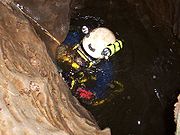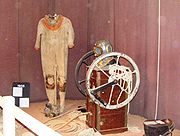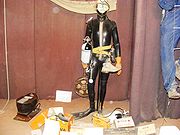
Cave Diving Group
Encyclopedia

Cave diving
Cave diving is a type of technical diving in which specialized equipment is used to enable the exploration of caves which are at least partially filled with water. In the United Kingdom it is an extension of the more common sport of caving, and in the United States an extension of the more common...
.
The CDG was founded in 1946 by Graham Balcombe
Graham Balcombe
Graham Balcombe born Francis Graham Balcombe in Manchester, was a pioneer of cave diving in the United Kingdom and a founder of the Cave Diving Group together with Jack Sheppard....
, making it the world's oldest continuing diving club. Graham Balcombe and Jack Sheppard
Jack Sheppard (cave diver)
Jack Sheppard , born John Arthur Sheppard in Lewisham, Kent , was a pioneer of cave diving in the United Kingdom and a founder of the Cave Diving Group together with Graham Balcombe....
pioneered cave diving in the late 1930s, notably at Wookey Hole in Somerset
Somerset
The ceremonial and non-metropolitan county of Somerset in South West England borders Bristol and Gloucestershire to the north, Wiltshire to the east, Dorset to the south-east, and Devon to the south-west. It is partly bounded to the north and west by the Bristol Channel and the estuary of the...
.
Passages through caves are often blocked by a submerged section, or sump
Sump (cave)
Sump is a term used in caving to describe a submerged passage in a cave. A sump may be static, with no inward or outward flow, or active, with continuous through-flow...
. Cavers in many countries have tried to pass these barriers in a variety of ways; using the simple "free dive" with a lungful of air or by utilising the available diving technology of the day.
Early history of cave diving in the UK


Swildon's Hole
Swildon's Hole is an extensive cave in Priddy, Somerset. At in length, it is the longest cave on the Mendip Hills. It has been found to be connected to Priddy Green Sink and forms part of the Priddy Caves Site of Special Scientific Interest ....
sump. Their pioneering dive on 17 February 1934 used a home-made respirator, designed by Balcombe, that incorporated part of a ladies bicycle frame. The attempt was unsuccessful but the foundation of cave diving in the U.K. had been laid.
In 1935, Balcombe made enquiries with Siebe Gorman
Siebe Gorman
Siebe Gorman & Company Ltd was a British company which developed diving equipment and breathing equipment and worked on commercial diving and marine salvage projects...
, the leading diving engineers of the time. Although they could not help with light weight diving equipment
Diving equipment
Diving equipment is equipment used by underwater divers for the purpose of facilitating diving activities. This may be equipment primarily intended for this purpose, or equipment intended for other puprposes which is found to be suitable for diving use....
, they did offer training and the loan of standard helmet diving gear
Standard diving dress
A standard diving dress consists of a metallic diving helmet, an airline or hose from a surface supplied diving air pump, a canvas diving suit, diving knife and boots...
.
A successful expedition was mounted at Wookey Hole, where the waters from Swildon's Hole resurge. Exploration of the subterranean River Axe proceeded to the seventh chamber, a distance of 52 m (170.6 ft), which was as far as the divers could physically handle their pipes and ropes.
The team returned to Swildon's Hole on 4 October 1936 with Jack Sheppard's newly designed apparatus nicknamed "Jimmy". It was fed by a football inflation pump that was coupled to a home-made drysuit that incorporated lighting and a telephone. This was used by Sheppard to pass Sump l.
Later that year the bicycle respirator became self-contained with the addition of an oxygen
Oxygen
Oxygen is the element with atomic number 8 and represented by the symbol O. Its name derives from the Greek roots ὀξύς and -γενής , because at the time of naming, it was mistakenly thought that all acids required oxygen in their composition...
cylinder. In turn Balcombe dived solo through Sump 1 and found the air chambers of Sump 2. These pioneers established the pattern of UK cave diving; the systematic exploration of a cave system in its phreatic
Phreatic
The term phreatic is used in Earth sciences to refer to matters relating to ground water below the water table . The term 'phreatic surface' indicates the location where the pore water pressure is under atmospheric conditions...
zone by diving both the resurgence and its tributaries. During the war years Balcombe developed a self-contained closed-circuit oxygen set using mainly medical components. In the Yorkshire Dales
Yorkshire Dales
The Yorkshire Dales is the name given to an upland area in Northern England.The area lies within the historic county boundaries of Yorkshire, though it spans the ceremonial counties of North Yorkshire, West Yorkshire and Cumbria...
he began the great canon of exploration, now known as the "Three Counties System" with dives at Keld Head, Goyden Pot and Alum Pot.
Formation of the Cave Diving Group
After World War IIWorld War II
World War II, or the Second World War , was a global conflict lasting from 1939 to 1945, involving most of the world's nations—including all of the great powers—eventually forming two opposing military alliances: the Allies and the Axis...
surplus oxygen rebreather
Rebreather
A rebreather is a type of breathing set that provides a breathing gas containing oxygen and recycled exhaled gas. This recycling reduces the volume of breathing gas used, making a rebreather lighter and more compact than an open-circuit breathing set for the same duration in environments where...
equipment became available, and the number of divers increased. In 1946 these enthusiasts had a meet in South Wales
South Wales
South Wales is an area of Wales bordered by England and the Bristol Channel to the east and south, and Mid Wales and West Wales to the north and west. The most densely populated region in the south-west of the United Kingdom, it is home to around 2.1 million people and includes the capital city of...
during which they formed the Cave Diving Group. Wookey Hole once more became the focus of diving activities. In addition to exploration, the early divers found a lot of archaeological material.
As the divers penetrated deeper into the cave, the need for penetration below 9 m (29.5 ft) (the safe limit of oxygen diving) became more urgent, and the first attempt with an early aqualung
Aqua-lung
Aqua-Lung was the original name of the first open-circuit free-swimming underwater breathing set in reaching worldwide popularity and commercial success...
nearly ended in tragedy. Following this incident, the group concentrated on the use of semi-closed circuit rebreathers with oxygen/nitrogen mixtures (nitrox) suitable for the depth. In 1960 the way forward at Wookey Hole was found at a depth of 21 m (68.9 ft), using 60/40 O2/N2. Rebreathers were also used successfully in South Wales, Derbyshire
Derbyshire
Derbyshire is a county in the East Midlands of England. A substantial portion of the Peak District National Park lies within Derbyshire. The northern part of Derbyshire overlaps with the Pennines, a famous chain of hills and mountains. The county contains within its boundary of approx...
and Yorkshire
Yorkshire
Yorkshire is a historic county of northern England and the largest in the United Kingdom. Because of its great size in comparison to other English counties, functions have been increasingly undertaken over time by its subdivisions, which have also been subject to periodic reform...
.
Accomplishments
During the 60s, with the abandonment of National ServiceNational service
National service is a common name for mandatory government service programmes . The term became common British usage during and for some years following the Second World War. Many young people spent one or more years in such programmes...
, there was an increase in caving activity by the post-war population bulge. Readily available commercial scuba equipment
Scuba set
A scuba set is an independent breathing set that provides a scuba diver with the breathing gas necessary to breathe underwater during scuba diving. It is much used for sport diving and some sorts of work diving....
was adapted to cave diving. The process was accelerated by the Cave Diving Group's publication of "Cave Diving on Air" by Mike Boon and the formation of the Independent Cave Diving Group.
Divers began to dive deeper and further, and inevitably there were tragedies. Two innovations were introduced in the interest of safety. Separate cylinders
Diving cylinder
A diving cylinder, scuba tank or diving tank is a gas cylinder used to store and transport high pressure breathing gas as a component of a scuba set. It provides gas to the scuba diver through the demand valve of a diving regulator....
, each one with an independent demand valve; and the adoption of the "Rule of Thirds
Rule of thirds (diving)
In scuba diving, the rule of thirds is a rule of thumb that divers use to plan dives so they do not consume all the breathing gas from the diving cylinder before the end of the dive....
": one third in, one third out, with one third kept as a safety reserve.
In the early days of cave diving in the UK there was always the hope of finding a way into the cave for the benefit of dry cavers. Amongst these must be mentioned Swildon's Hole
Swildon's Hole
Swildon's Hole is an extensive cave in Priddy, Somerset. At in length, it is the longest cave on the Mendip Hills. It has been found to be connected to Priddy Green Sink and forms part of the Priddy Caves Site of Special Scientific Interest ....
, Stoke Lane Slocker
Stoke Lane Slocker
Stoke Lane Slocker is a cave near Stoke St Michael, in the carboniferous limestone of the Mendip Hills, in the English county of Somerset.It is 2.18km in length and reaches a depth of 30m....
, Ogof Ffynnon Ddu II
Ogof Ffynnon Ddu
Ogof Ffynnon Ddu is a cave located under a hillside in the area surrounding Penwyllt in the Upper Swansea Valley in South Wales...
and Little Neath River Cave.
Progress and development of equipment and techniques have always come in phases, and with this progress, although still hoping to discover dry caves, came diving of a purely exploratory nature. This has led to advances at Wookey Hole and Cheddar Gorge caves in Somerset.
In Derbyshire a great deal of effort has produced significant discoveries in the Peak Cavern
Peak Cavern
The Peak Cavern, also known as the Devil's Arse , is one of the four show caves in Castleton, Derbyshire, England...
/Speedwell Cavern
Speedwell Cavern
The Speedwell Cavern is one of the four show caves in Castleton, Derbyshire, England.It consists of a horizontal lead miners' adit leading to the cavern itself, a limestone cave...
system. In South Wales many kilometres of Daren Cilau
Ogof y Daren Cilau
Ogof y Daren Cilau is one of several cave systems in the Llangattock escarpment near Crickhowell in south Powys, Wales.Its awkward 517m entrance crawl is a natural barrier to any casual visitor and precludes the need for a locked gate to protect it from vandals.Highlights of Daren Cilau include the...
were first trodden by cave divers; and the link with Elm Hole and Pwll y Cwm was another major feat.
In the north of England, divers have made discoveries such as Boreham Cave, Notts Pot II and the connection between Gaping Gill
Gaping Gill
Gaping Gill is a natural cave in North Yorkshire, England. It is one of the unmistakable landmarks on the southern slopes of Ingleborough – a deep pothole with the stream Fell Beck flowing into it...
and Ingleborough Cave
Ingleborough Cave
Ingleborough Cave is a show cave close to the village of Clapham, North Yorkshire, England adjacent to where the water from Gaping Gill resurges....
and that between Gavel Pot and Pippikin Pot. Keld Head in Kingsdale has been the scene of operations over many years and the 2000 m (6,561.7 ft) dive through from Kingsdale Master Cave represented a world standard. Later the dive was started from King Pot in the same cave system, a different route with a distance of 3050 m (10,006.6 ft).
In Ireland CDG members dived the connection between Noon's Hole and Arch Cave, and between Prod's Pot and Cascades Rising and between Polloughabo and Polbehan.
Several expeditions have connected two or more caves together. This tendency to explore water filled caves has been extended abroad to such places as the Bahamas, where there are flooded ocean Blue Hole
Blue Hole
Blue Hole is a diving location on east Sinai, a few kilometres north of Dahab, Egypt on the coast of the Red Sea.The Blue Hole is a submarine sinkhole , around 130 m deep. There is a shallow opening around 6 m deep, known as 'the saddle', opening out to the sea, and a 26 m long...
s. These have been explored by British divers since the early 1980s; several have been connected. CDG members have been active in exploring many sites in Europe and further afield, often using or pioneering the cutting edge of technology.
Organisation and purpose
The Cave Diving Group operates under a federal structure comprising four regionally based sections located in the major caving districts of Britain: Somerset, Welsh, Derbyshire and Northern, each with its own Secretary, Teasurer and Training Officer. These are governed loosely by a Central Committee which comprises national officers which oversees the running of the Group and liases with other bodies.The Cave Diving Group has traditionally not actively recruited members – a position adopted early on in its history when the availability of training and equipment was scarce. Likewise, owing to early fatalities in the sport, cave divers in the United Kingdom (unlike other areas of the world) have usually been represented by cavers who wished to dive. It is a condition of qualification as a cave diver within the CDG that the candidate is an experienced caver as well as a skilled cave diver.
A candidate for membership applies to one of the regional sections, making themselves and their experience known to members. They must be over 18 years old and in good health, never having suffered from epilepsy. Training is provided on a regional basis with national training camps under a loose mentoring system. Final election to qualification is carried out by the candidate's peers - other diving members of the section.
The Group also welcomes non-diving members who wish to be associated with its activities; they receive all publications, may attend all meetings but pay a reduced subscription. Of great importance is the Group's role in publishing information about exploration by members (and others) and developments in cave diving techniques. The Group produces a quarterly newsletter and a training manual. Sump Indices are available for each cave diving region (Somerset, Wales, Derbyshire & Northern) of Great Britain which summarise diving activities from Group members and non-members over many years. The newsletter is free to members and on sale to the public as are all the other publications.
Members of the CDG are sometimes called upon to assist in cave rescue, particularly of cavers trapped by flood waters.

